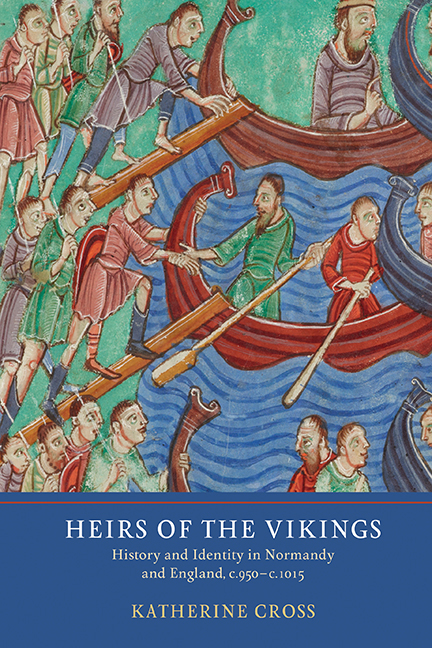Book contents
- Frontmatter
- Dedication
- Contents
- List of illustrations
- Acknowledgements
- Abbreviations
- Note on terminology
- Map
- Introduction: The Problem of Viking Identity
- 1 Genealogy: Building a Viking Age Dynasty
- 2 Origin Myths: A People for a Dynasty
- 3 Hagiography I: Ruin and Restoration
- 4 Hagiography II: Saintly Patronage
- 5 Charter Narratives: Normans, Northumbrians and Northmen
- Conclusion: Viking Age Narratives and Ethnic Identities
- Appendix 1 The Date of Fulbert's Vita Romani
- Appendix 2 The Dates of the Latin Vita Prima Sancti Neoti and the Old English Life of St Neot
- Bibliography
- Index
Appendix 1 - The Date of Fulbert's Vita Romani
Published online by Cambridge University Press: 19 July 2019
- Frontmatter
- Dedication
- Contents
- List of illustrations
- Acknowledgements
- Abbreviations
- Note on terminology
- Map
- Introduction: The Problem of Viking Identity
- 1 Genealogy: Building a Viking Age Dynasty
- 2 Origin Myths: A People for a Dynasty
- 3 Hagiography I: Ruin and Restoration
- 4 Hagiography II: Saintly Patronage
- 5 Charter Narratives: Normans, Northumbrians and Northmen
- Conclusion: Viking Age Narratives and Ethnic Identities
- Appendix 1 The Date of Fulbert's Vita Romani
- Appendix 2 The Dates of the Latin Vita Prima Sancti Neoti and the Old English Life of St Neot
- Bibliography
- Index
Summary
The date of composition of Fulbert's Vita Romani is important for the arguments contained in Chapter 3 of this book because of the particular narrative of viking invasion and domination that it contains – a narrative that is absent from all other texts related to the cult of Romanus. I believe that Fulbert wrote his text in the mid-tenth century, and therefore that this narrative represents an early vision of ethnic relations in Normandy, before a standard account had come to dominate: these arguments are rehearsed in Chapter 3. If I am wrong, and Fulbert wrote in the mid-eleventh century, then this would suggest that more varied narratives of the relations between vikings and local inhabitants continued to circulate long into the ducal period.
Fulbert's Vita Romani was largely unknown to modern scholarship until Felice Lifshitz completed her study of Romanus's dossier. Although it now exists in only two manuscripts, the many other texts Lifshitz has surveyed which depend on it reveal a much wider medieval circulation. Lifshitz concluded that the Vita Romani was composed by a certain Fulbert in the mid-tenth century, probably in 943. If we accept this date, then the Vita Romani was one of the earliest literary products from Normandy and, alongside the Planctus of William Longsword, the earliest Norman text to refer to the viking period. Fulbert had previously been identified with either of two Fulberts who were active in Rouen in the mid-eleventh century. More recently, several scholars have disputed Lifshitz's dating of Fulbert's Vita, and even returned to these identifications. However, Lifshitz's argument is the only one to make sense of all the internal, contextual and manuscript evidence, a conclusion also reached recently by John Howe.
Fulbert's Vita Romani is related to several other hagiographical texts. It is only through assessing the arguments for these connected texts’ dates of composition that a conclusion regarding the date of the Vita Romani can be drawn. Here I lay out the crucial connections between Fulbert's Vita Romani and these texts, with a particular focus on issues of authorship.
The first group of texts related to Fulbert's Vita Romani involves an alternative, shorter, version of the Vita, which exists in several copies. This Vita is associated with a letter from Gerard, ‘pater cenobitarum’, addressed to Uuigo or Hugo, archbishop of Rouen.
- Type
- Chapter
- Information
- Heirs of the VikingsHistory and Identity in Normandy and England, c.950–c.1015, pp. 215 - 222Publisher: Boydell & BrewerPrint publication year: 2018



